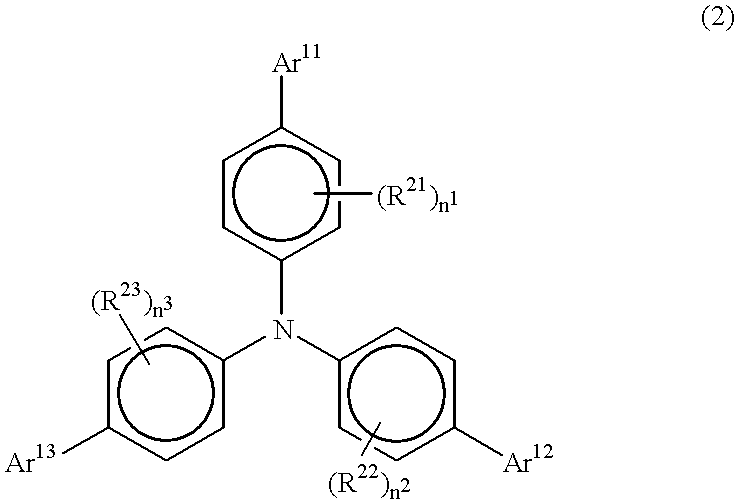Cyclocondensed polycyclic hydrocarbon compound and light-emitting device using the same
a technology of cyclocondensed polycyclic hydrocarbons and light-emitting devices, which is applied in the direction of discharge tube luminescnet screens, natural mineral layered products, etc., can solve the problems of inferior luminescence luminance and light-emission efficiency of blue light-emitting devices fabricated by vapor deposition, and achieve good luminescence properties
- Summary
- Abstract
- Description
- Claims
- Application Information
AI Technical Summary
Benefits of technology
Problems solved by technology
Method used
Image
Examples
example 1
[0071] A device was prepared in the same manner as with Comparative Example 1 with the exception that compound (1-1) of the invention was used in place of compound A used in Comparative Example 1. The device was evaluated in the same manner as with Comparative Example 1. As a result, blue-green luminescence of (0.19, 0.29) and a maximum luminance of 4280 cd / m.sup.2 were obtained. Even when the device was allowed to stand for one day in an atmosphere of nitrogen, an organic film was transparent.
example 2
[0072] A washed ITO substrate was placed in a vapor deposition apparatus, and vapor deposited with .alpha.-NPD (N,N'-diphenyl-N,N'-di (.alpha.-naphthyl)-benzidine) to a thickness of 40 nm. Then, distyryl compound A and compound (1-1) of the invention (distyryl compound A : compound (1-1)=50:1) were concurrently vapor deposited thereon to a thickness of 20 nm, azole compound B was vapor deposited thereon to a thickness of 40 nm, and a cathode was vapor deposited in the same manner as with Comparative Example 1, thereby preparing a device. The device was evaluated in the same manner as with Comparative Example 1. As a result, blue luminescence of (0.16, 0.15) and a maximum luminance of 9600 cd / m.sup.2 were obtained. Even when the device was allowed to stand for one day in an atmosphere of nitrogen, an organic film was transparent.
example 3
[0073] Polyvinylcarbazole (40 mg), 12 mg of PBD (p-t-butyl-phenyl-biphenyl--1,2,4-oxadiazole) and 1 mg of compound (1-1) of the invention were dissolved in 3 ml of dichloroethane, and the resulting solution was applied onto a washed substrate by spin coating (2000 rpm, 5 seconds). A cathode was vapor deposited in the same manner as with Comparative Example 1, thereby preparing a device. The device was evaluated in the same manner as with Comparative Example 1. As a result, blue luminescence of (0.15, 0.15) and a maximum luminance of 3180 cd / m.sup.2 were obtained.
PUM
| Property | Measurement | Unit |
|---|---|---|
| work function | aaaaa | aaaaa |
| thickness | aaaaa | aaaaa |
| thickness | aaaaa | aaaaa |
Abstract
Description
Claims
Application Information
 Login to View More
Login to View More - R&D
- Intellectual Property
- Life Sciences
- Materials
- Tech Scout
- Unparalleled Data Quality
- Higher Quality Content
- 60% Fewer Hallucinations
Browse by: Latest US Patents, China's latest patents, Technical Efficacy Thesaurus, Application Domain, Technology Topic, Popular Technical Reports.
© 2025 PatSnap. All rights reserved.Legal|Privacy policy|Modern Slavery Act Transparency Statement|Sitemap|About US| Contact US: help@patsnap.com



